
Glass vs. Plastic: Which Bottled Water Delivery Option Is Healthier for Your Team?
Choosing the right bottled water for your team isn’t just about quenching thirst; it’s about health and well-being. With rising concerns over plastic pollution and water quality, you might be wondering which option-glass or plastic-truly benefits your group. This article looks into the health effects, environmental issues, and cost differences between these two options. Want to find out which bottled water delivery method can improve your team’s hydration and spirit? Let’s dive in!
Overview of Bottled Water Options
Bottled water is available in different types such as spring, purified, mineral, and sparkling, to suit various tastes, health requirements, and promote modern hydration trends.
Spring water comes from natural springs and contains minerals such as calcium and magnesium, which are great for those who love staying hydrated and value water purity.
Purified water goes through extensive filtration to remove contaminants, making it safe for those concerned about pollution and health hazards.
Mineral water contains specific mineral content beneficial for health, often recommended for its potential digestive and bone health benefits.
Sparkling water adds carbonation, providing a refreshing alternative to sugary sodas, and is perfect for social settings or as a mixer in cocktails.
Choosing the right type depends on your taste preferences and health goals. Curious about which bottled water is safest? Our review provides insights into the healthiest options.
Importance of Water Quality for Teams
Good water quality is important for team productivity, employee health, and workplace efficiency because it affects hydration and health.
Studies indicate that drinking enough water can greatly improve concentration and energy. For instance, a study published in the ‘Journal of Occupational and Environmental Medicine’ found that hydrated employees can experience up to a 20% increase in productivity, highlighting the importance of workplace hydration and health studies.
To keep water clean and safe, companies should buy filtered water systems. Brands like Brita and Pur offer good choices. Incorporating regular hydration breaks throughout the workday can help maintain energy levels and support team wellness initiatives.
Encouraging staff to keep reusable bottles at their desks can also promote consistent water intake and reinforce eco-consumerism practices.
Health Considerations
When choosing bottled water, knowing about health effects from packaging and contaminants is very important for consumer safety and health consciousness. For those weighing their options, comparing bottled water to tap water can provide additional insights into making healthier choices.
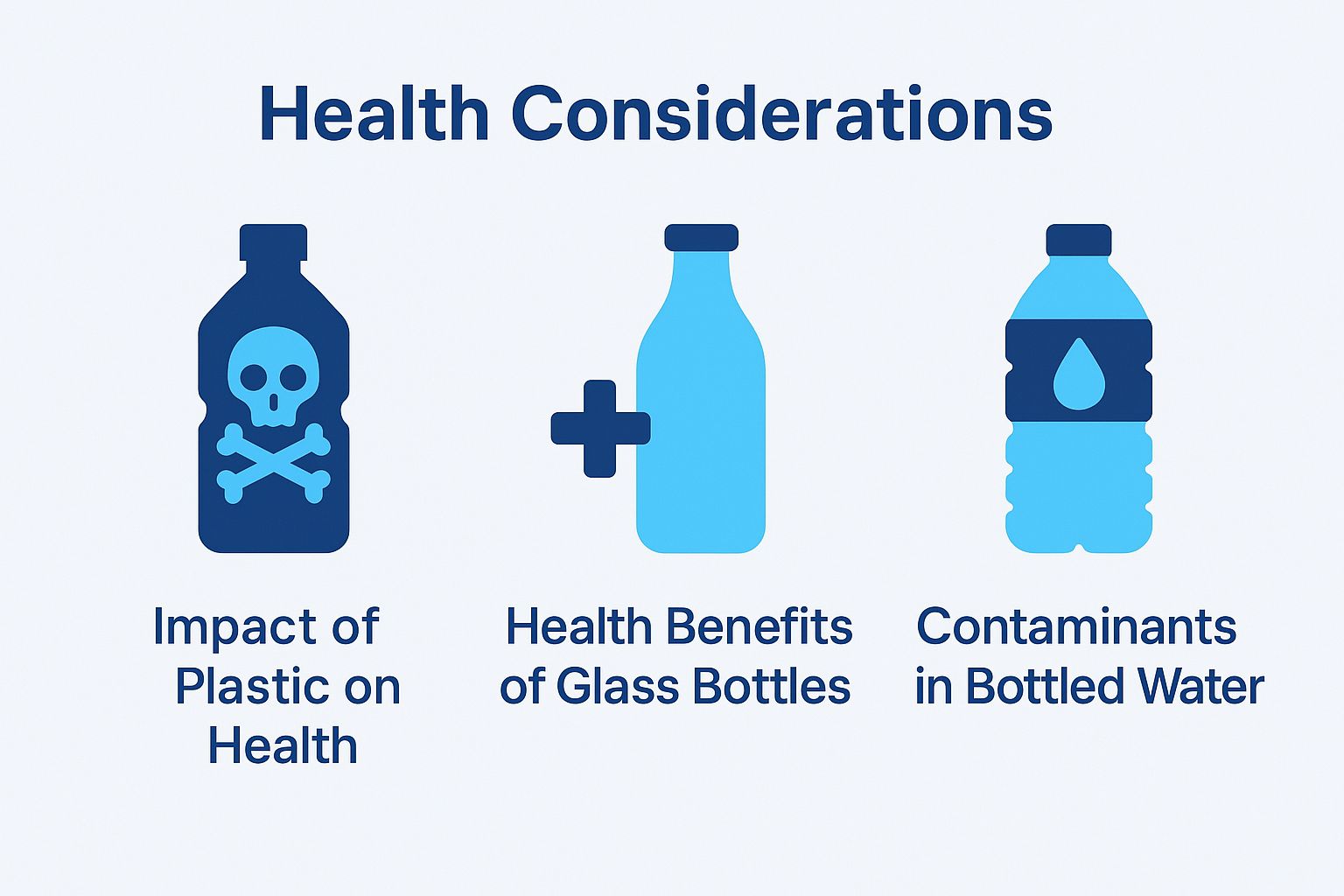
Impact of Plastic on Health
Plastic bottles may leach harmful chemicals like BPA into the water, raising significant health concerns for consumers and impacting personal choice.
Research shows that BPA exposure can cause health problems like hormone changes and a higher chance of cancer.
To mitigate these risks, consider opting for BPA-free plastic bottles. Brands like Aquafina and Dasani offer BPA-free options, ensuring safer hydration.
Stainless steel or glass bottles are excellent alternatives, providing durability without chemical leaching. Look for certification marks on packaging to confirm BPA-free status, ensuring the health and safety of you and your family while staying environmentally conscious.
Health Benefits of Glass Bottles
Glass bottles are becoming more popular because they don’t react with the contents, keeping the water pure.
This purity makes the taste better and significantly reduces exposure to harmful chemicals usually present in the production of plastic bottles.
Brands like Lifefactory offer glass options with protective silicone sleeves, combining durability with safety. Using glass bottles promotes environmental sustainability; as they are reusable and recyclable, they help reduce plastic waste.
To integrate this into your lifestyle, consider replacing single-use plastic bottles with sturdy glass alternatives for daily hydration, whether at home or on the go.
Contaminants in Bottled Water
Contaminants in bottled water can include nitrates, chlorine, and heavy metals, which can pose serious health risks.
Research from the EPA has shown that bottled water may sometimes contain harmful levels of these substances due to environmental pollution or inadequate filtration during processing.
Testing your bottled water regularly is important. Think about buying testing kits that can check for things like lead and bacteria.
Putting in a home filtration system, such as a reverse osmosis unit, helps reduce risks and provides cleaner drinking water.
Check the brands you use and look at independent testing reports to confirm quality.
Environmental Impact
The environmental impact of bottled water, especially related to plastic waste and production emissions, is worrying more and more consumers. To better understand the distinction between bottled water and tap water and which might be more beneficial for reducing environmental harm, you can explore the insights provided in Bottled Water vs Tap Water? Which Is Better?.
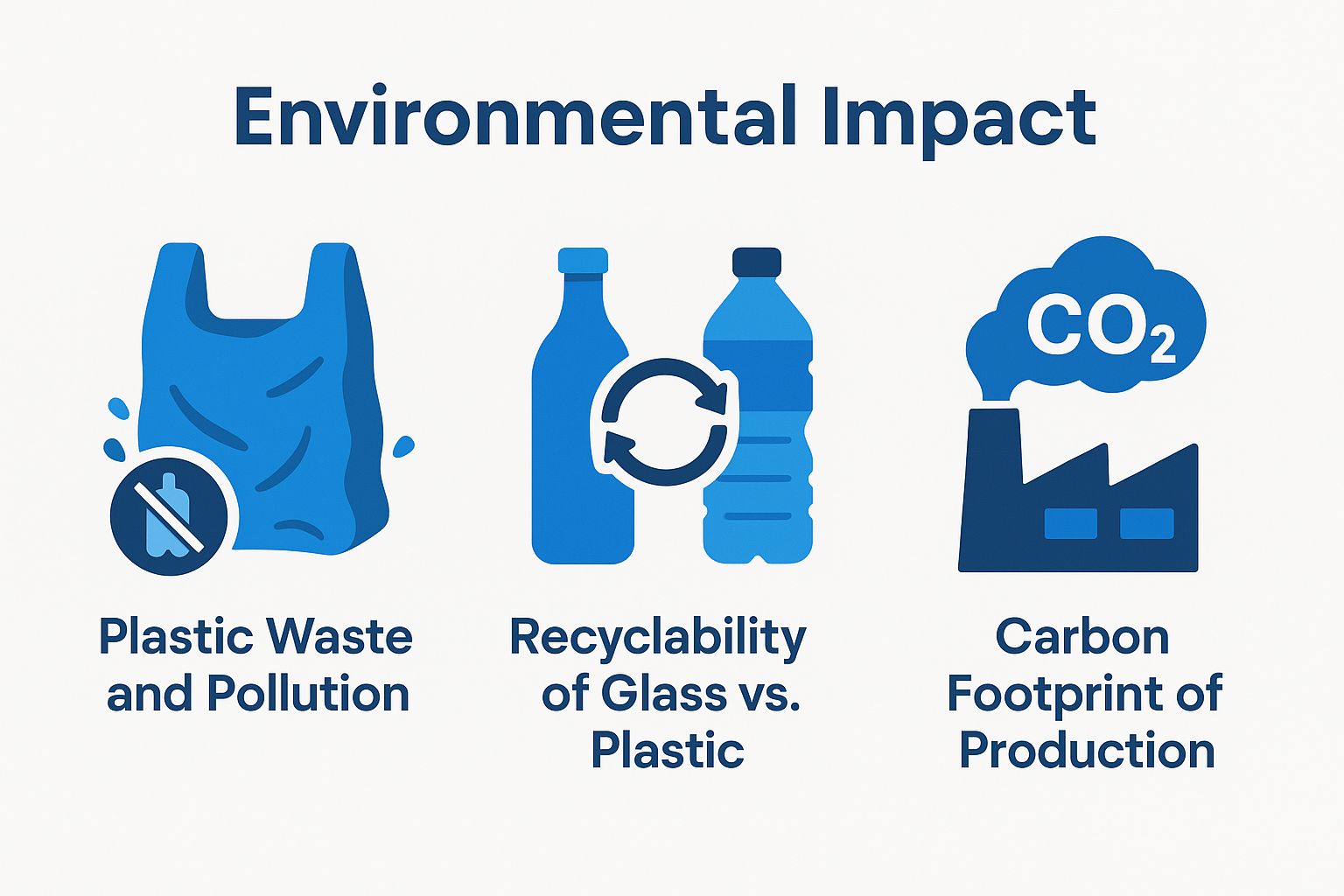
Plastic Waste and Pollution
Plastic bottles contribute to over 1 million metric tons of ocean pollution annually, highlighting the urgent need for sustainable alternatives.
Individuals can significantly reduce plastic waste by adopting a few practical habits. Start by switching to refillable water bottles, which can save up to 167 single-use bottles per person per year.
Consider using bulk-buying options at grocery stores to minimize packaging waste. Companies can also play a role by embracing packaging-free shipping methods or using biodegradable materials.
Implementing recycling programs within offices can further cut down on plastic usage. Together, these steps support a healthier environment and promote sustainable practices.
Recyclability of Glass vs. Plastic
Glass bottles are 100% recyclable and can be reused indefinitely without loss of quality, unlike plastic which often degrades.
The recyclability of glass significantly reduces environmental impact. According to the Container Recycling Institute, recycling glass saves 66% of the energy required to produce new glass from raw materials.
In contrast, only about 9% of plastic is recycled due to complex processes and contamination issues. Glass can be turned into new bottles many times, but plastic is usually made into lower-quality items after only a few uses.
This durability and effectiveness make glass a much more sustainable choice for packaging.
Carbon Footprint of Production
Making plastic bottles releases more carbon emissions compared to making glass bottles. Therefore, it’s important to consider the environment when selecting materials.
According to a 2022 report from the Environmental Protection Agency (EPA), plastic production emits approximately 2.5 times more greenhouse gases compared to glass. For instance, creating one ton of plastic generates around 3,000 pounds of CO2, while glass production results in about 1,200 pounds.
Brands committed to sustainability, like Coca-Cola, have pledged to increase the recycled content in their products, aiming for 50% by 2030. Working with these brands helps meet environmental goals and builds consumer trust and loyalty.
Cost Analysis
Comparing the price of water in glass bottles to plastic bottles helps you make informed purchasing decisions. For a deeper understanding of cost factors, including packaging differences, learn more about calculating the true cost of office water services.
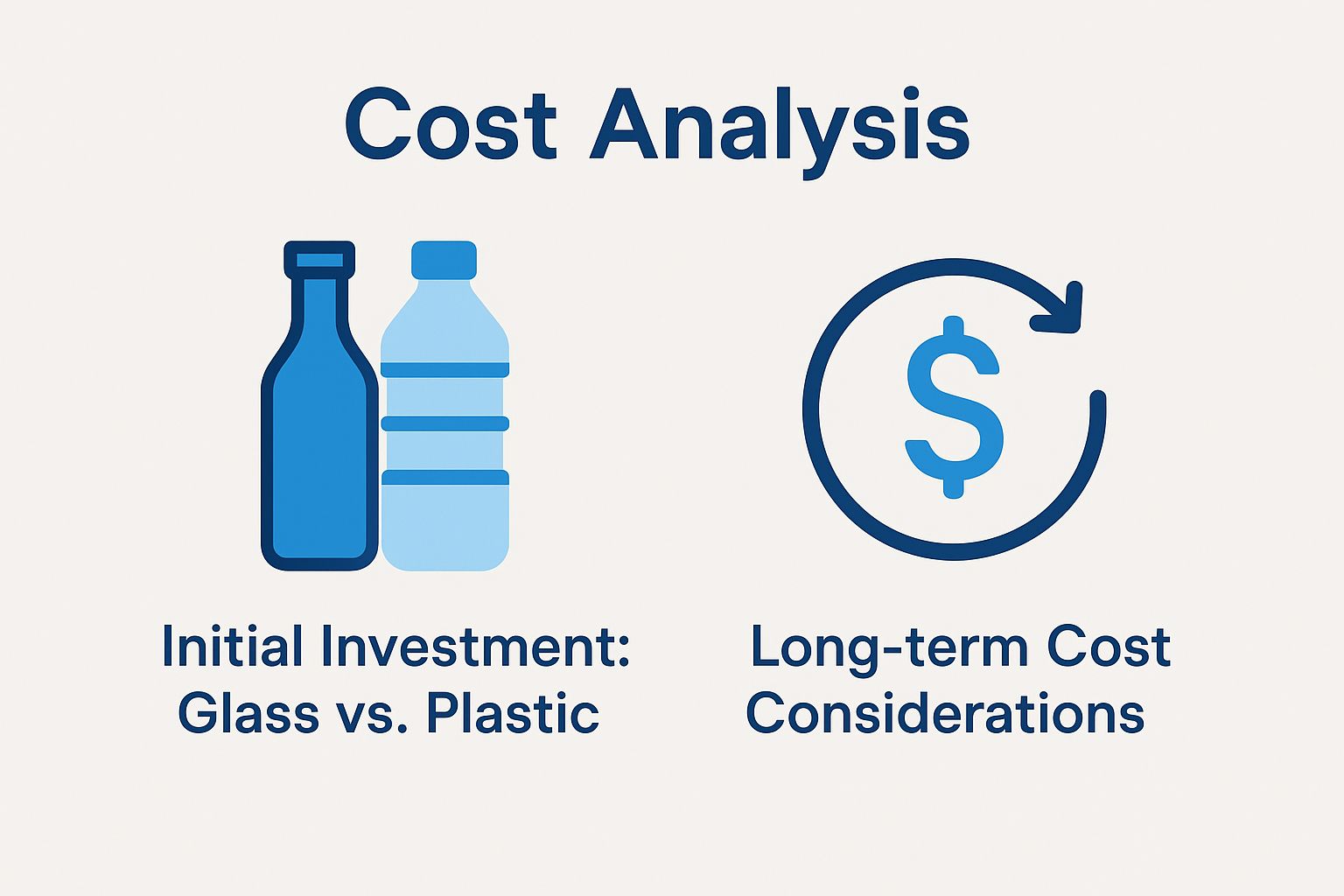
Initial Investment: Glass vs. Plastic
The initial investment for glass bottles can be higher than plastic, with typical costs around $1.50-$3 per glass bottle compared to $0.50 for plastic.
In bulk, costs can decrease significantly. For example, a box of 24 glass bottles may drop to around $1.20 each, while a similar bulk purchase of plastic bottles might net a price of $0.30 each.
Brands like Anchor Hocking for glass and Carlisle for plastic often offer these bulk rates. Consider the long-term savings: glass bottles are reusable and can last years, reducing overall replacement costs compared to single-use plastic, which may need frequent replenishment.
Long-term Cost Considerations
When considering long-term costs, glass bottles prove to be more economical due to their durability and reusability, often lasting years.
In contrast, single-use plastic bottles may seem cheaper initially but require constant replacement, which adds up over time.
For example, if you buy a plastic bottle for $1 each month, you’ll spend $12 in a year. Conversely, a glass bottle may cost $10 but can last for years with proper care.
Purchasing refills in large quantities can lower the price of your drink, leading to greater savings.
Over five years, the savings can be substantial, especially if you make the switch to refillable glass options for your daily hydration needs.
Durability and Storage
Knowing how long bottled water can last and how to store it properly is important for keeping it safe and in good condition.
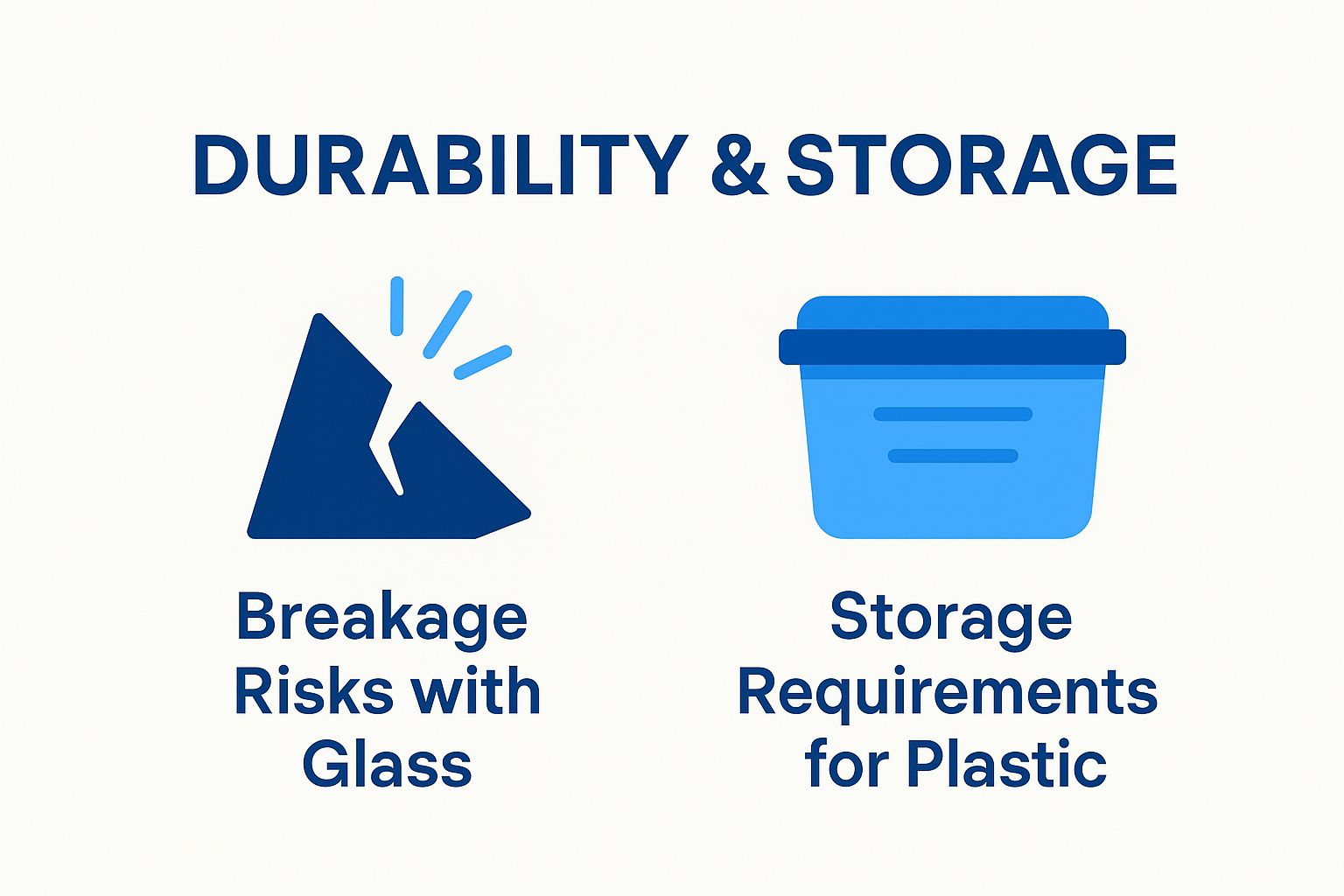
Breakage Risks with Glass
Glass bottles, while aesthetically pleasing, pose breakage risks that can lead to safety concerns and potential waste.
To minimize these risks, consider using silicone sleeves which provide cushioning and improve grip, significantly reducing the chances of drops.
Storing glass bottles in secure areas, away from high-traffic zones, can also lessen the likelihood of accidental breakage.
For people who often carry drinks, choosing strong, insulated holders made for glass can provide more protection.
Regularly checking bottles for chips or cracks is important; even small damages can affect safety, so replacing damaged bottles is advised for reassurance, contributing to a longer product lifecycle.
Storage Requirements for Plastic
Plastic bottles require specific storage conditions to prevent deformation and maintain water quality over time.
To preserve their integrity, store plastic bottles in a cool, dark area where temperatures remain between 50 degreesF and 70 degreesF. Avoid placing them in direct sunlight, as UV rays can degrade the plastic, causing leaching.
Keep bottles upright to prevent accidental puncturing. Regularly check for any signs of wear, such as cracks or discoloration, and recycle bottles that show these signs.
By following these steps, you can keep your plastic bottles safe and useful for a longer time.
Flavor and Quality
The type of material used for bottled water containers can significantly change the taste and quality of the water, making it possible to compare different materials.
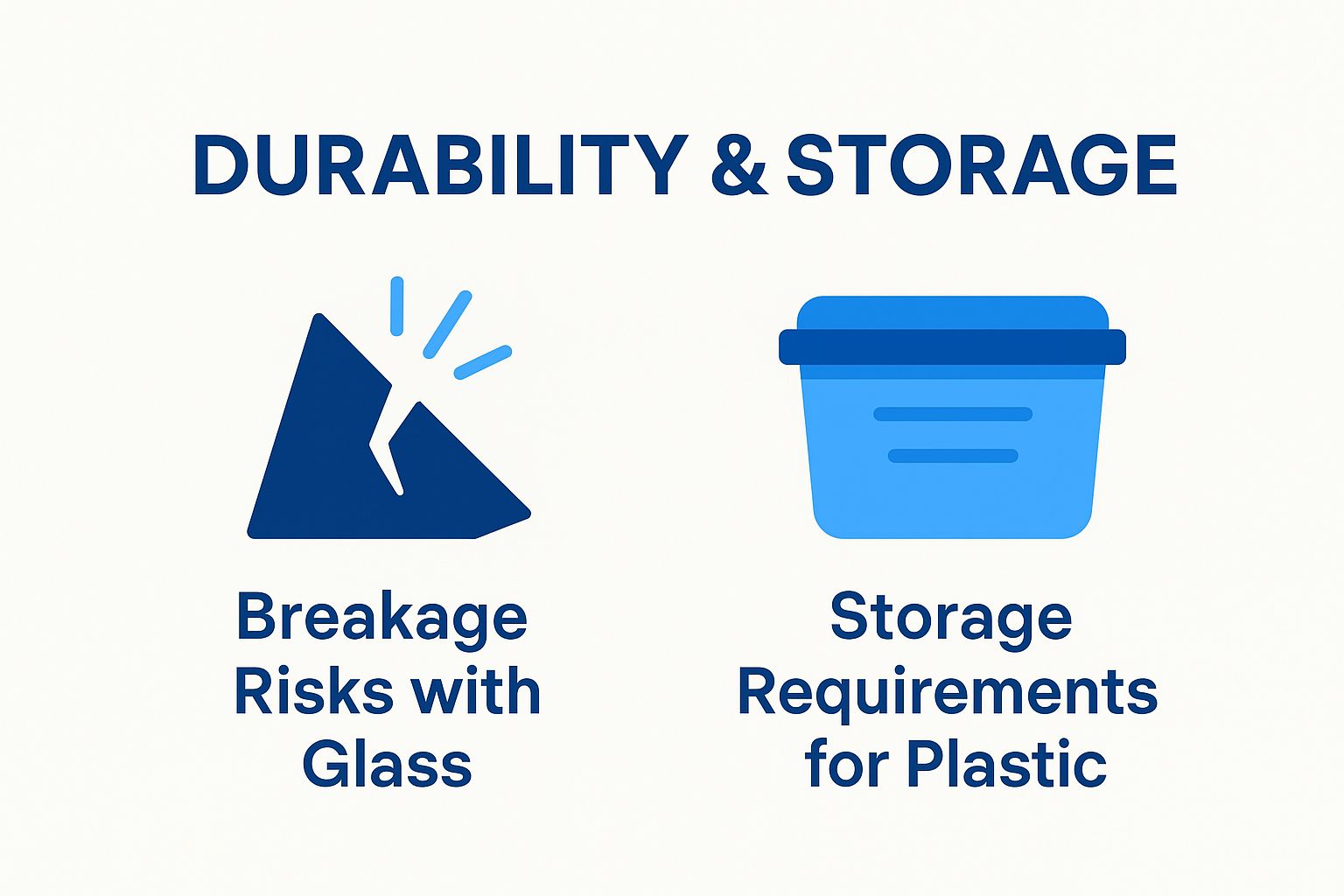
Impact of Material on Water Taste and Taste Differences
Plastic can impart a distinct taste to water, unlike glass, which maintains the purity and flavor over time, highlighting the taste differences between materials.
To look into this more, think about doing a taste test with people using different water sources. Use three types of water: one from a glass bottle, another from a high-quality plastic bottle, and a third from a standard plastic bottle.
Gather subjective feedback on taste, clarity, and overall enjoyment. A basic survey tool like Google Forms can make data collection easier. Monitor consumer reviews on bottled water brands, observing comments that note taste preferences related to packaging. This approach highlights differences and collects real-world information about how consumers see things.
Preservation of Water Quality Over Time
Glass bottles preserve the quality of water far better than plastic, preventing chemical leaching and taste alteration.
Studies indicate that water stored in glass bottles can remain uncontaminated for years, while plastic bottles may begin to degrade and release chemicals after just a few months.
For example, a study published in Environmental Science & Technology found that bottled water in polyethylene terephthalate (PET) containers exhibited a noticeable decline in taste and quality after six months, affecting the shelf life.
To maximize water quality, use glass or stainless steel containers for long-term storage. Avoid reusable plastic bottles if they show signs of wear to prevent potential contamination.
Team Preferences and Perceptions
Knowing what team members like and think can help decide whether to use glass or plastic bottled water at work.
Survey of Team Opinions and Employee Preferences
A recent survey revealed that 73% of team members prefer glass bottles over plastic for both taste and health reasons.
This choice is based on important reasons, such as health regulations and chemical additives concerns.
Many people believe water tastes better in glass bottles because glass doesn’t add any flavors, unlike plastic. Safety is another priority; respondents expressed concerns about chemicals leaching from plastic. Brand loyalty also played a significant role; popular brands like Lifewater and Fiji are often chosen for their perceived quality.
To match what the team likes, think about buying sturdy glass water bottles from trustworthy companies. You could set up a tasting event to understand and adjust to everyone’s likes.
Branding and Image Considerations and Public Perception
Choosing bottled water can greatly affect how people view a company’s brand. Many companies use glass bottles to improve their image as environmentally friendly.
Brands such as Glarus Water and Voss use glass bottles to show their dedication to caring for the environment. These companies often highlight their recyclable packaging and sustainable sourcing on their marketing platforms, resonating with eco-conscious consumers.
A case study on Glarus Water demonstrated a 30% rise in customer loyalty after switching to glass. This change highlights how focusing on eco-friendly methods can positively impact how people view the brand and increase sales.
In this way, the materials and messaging surrounding product packaging become integral to shaping consumer choice, aligning with corporate wellness programs and societal trends.
Final Recommendations
For optimal hydration and health, consider investing in BPA-free glass bottles and BPA-free plastic alternatives, which offer both safety and sustainability.
These glass bottles prevent harmful chemicals from getting into your water and can be used again, cutting down on plastic waste, supporting recycling rates.
You might check out choices like the Lifefactory 22-Ounce Glass Bottle, which comes with a silicone sleeve to make it more durable, or the Klean Kanteen Classic, which is appreciated for its simple design and different size options.
For added convenience and ergonomic design, look for bottles with an infuser, such as the Takeya Actives, which allows you to create refreshing fruit-infused water.
Investing in these bottles supports your hydration goals while promoting an eco-friendly lifestyle.
About the Author
I’m Jordan Matthews, a University of California, Berkeley graduate with a degree in Environmental Science. Over the past 18 years, I’ve helped companies across Seattle improve sustainability and employee wellness through smarter infrastructure and thoughtful planning. As a writer and editor for Office Water Services, I’m passionate about helping organizations align their values with the way they hydrate, build, and grow.

Leave a Reply